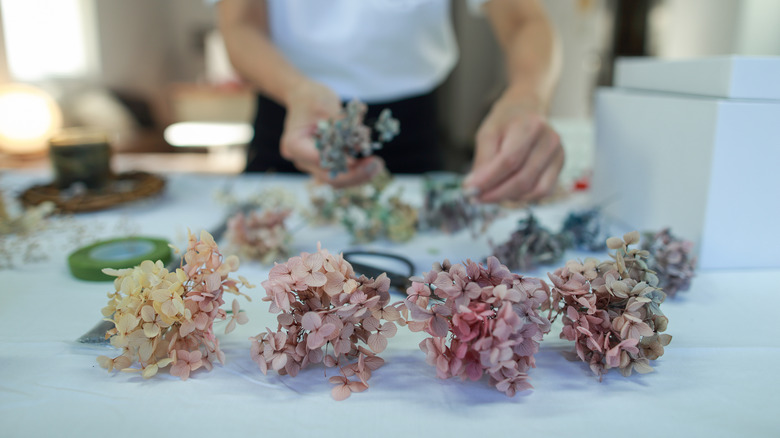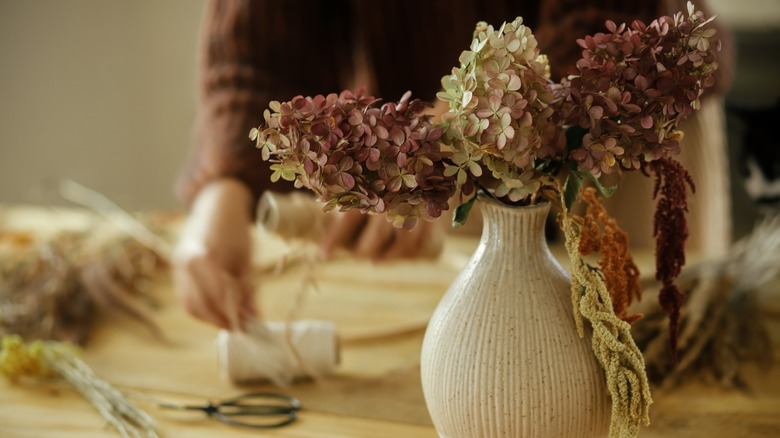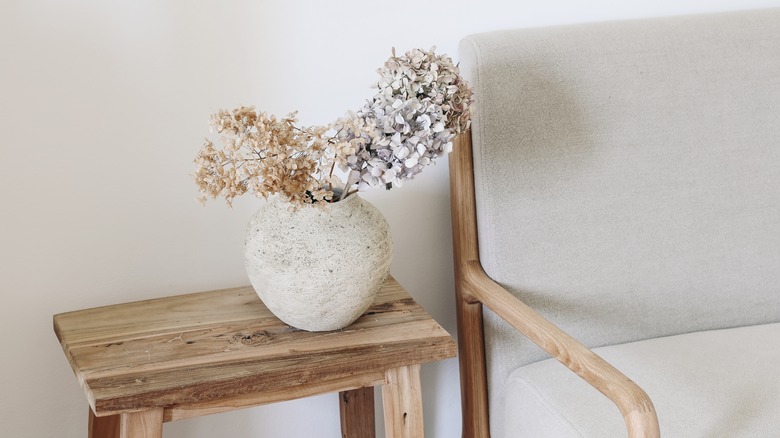How Martha Stewart Dries Her Hydrangeas To Use As A Centerpiece
Hydrangeas are a wonderful summer staple, flowering in bold blues, pinks, purples, and whites throughout the season. This gorgeous shrub blooms far longer than most other bushes, lasting from late spring until early autumn. Elongate the life of your hydrangeas by preserving those gorgeous blossoms and decorating your home with their elegant bursts of color. On her blog, Martha Stewart says, "Hydrangeas are popular ornamental plants, grown for their large flower heads, which are excellent in cut arrangements and for drying."
When done correctly, drying hydrangea blooms is an easy and creative way to bring nature inside. Once the blooms begin to dry on their own on the plant and the petals feel papery, it's time to harvest. Snip them with about 12 to 18 inches of stem attached, removing any remaining leaves. How you go about drying the flowers from here depends on the cost and level of effort you're willing to invest. The most cost-effective and easy approach is to hang the flowers upside down in a space with great airflow in your home. Another method only requires plopping the blooms in a vase of water and letting nature take its course. Finally, with a little more effort and cost, you can dry these flowers using silica. This method preserves the original color best.
Ways to dry hydrangea blooms
According to Martha Stewart, drying hydrangeas in a vase of water is an excellent method for preserving their vibrant colors and beautiful blooms. Choose hydrangea blooms that are healthy, avoiding blooms that are wilted or have brown spots, as those colors will remain on the dried flowers. Fill a vase with lukewarm water and arrange the hydrangea blooms in it, ensuring that the stems are fully submerged. You can put multiple stems in the same vase, but avoid overcrowding them. Place the vase in a cool, dry spot away from direct sunlight. Over the course of several weeks, the water in the vase will gradually evaporate, leaving behind dried hydrangeas. The drying process can take anywhere from one to three weeks, depending on the environmental conditions. Be patient and avoid disturbing the blooms during this time.
Preserving hydrangeas with silica gel is another effective method to maintain their color and shape, though it's pricier than drying them upside down or in a vase. Fill a container with silica gel, covering the bottom completely. Trim the stem of the hydrangea and place it upright in the container, gently pouring silica gel around it until fully covered. Carefully cover the entire bloom with more silica, completely surrounding it. Seal the container tightly and let it sit undisturbed for one to two weeks. Once dried, gently remove the blooms from the silica and arrange the flowers in a vase as a stunning centerpiece.
Other uses for dried hydrangeas
Aside from using dried hydrangeas as a charming centerpiece, these blooms offer beautiful options for various decorative purposes around your home. They make stunning additions to floral wreaths. You can mix them with other dried flowers, foliage, and decorative elements to create unique and long-lasting displays. Combine dried hydrangea blooms with dried lavender, baby's breath, or eucalyptus for a rustic arrangement. Using wire or a wreath base, attach your chosen flowers and hang your creation on your door, wowing your guests at your next gathering.
Dried hydrangea blooms can also be used as standalone decorative accents in your home. Place them in a vase or jar and display them on shelves, mantels, or as a focal point on a coffee table. Mix different-colored hydrangeas to create a visually appealing arrangement. Additionally, you can place individual dried blooms in small glass bottles or mason jars and scatter them throughout your home, adding a touch of elegance and natural beauty to any room.
If you're naturally crafty, dried hydrangeas can be used in a variety of DIY projects. For example, you can create unique and personalized greeting cards by attaching dried hydrangea petals to cardstock using glue or double-sided tape. Alternatively, incorporate dried hydrangeas into potpourri sachets or homemade candles to add a fragrant and decorative element to these items. Moreover, dried hydrangeas can be used in resin crafts, such as embedding them in clear resin to create beautiful and intricate pendants, coasters, ornaments, or even paperweights.


